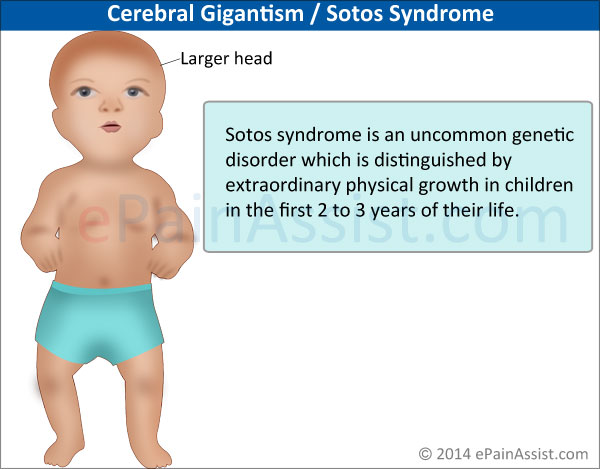Sotos syndrome, also termed as Cerebral Gigantism, is an uncommon genetic disorder, which is distinguished by extraordinary physical growth in children in the first 2 to 3 years of their life. This syndrome is generally accompanied with subtle mental retardation, autistic behavior, motor skills delays, cognitive disorder, muscle tone loss, and dysarthria. Children with this syndrome are extraordinarily large at birth and are taller, have more weight, and also tend to have larger heads than is the norm for a normal child. The indications for this disorder include children with an unusually large head also called as macrocephaly, extraordinarily big hands and feet, a condition called as hypertelorism. Such people also may have clumsiness. Even though such cases occur rarely, there have been evidences of a genetic link to it.

Signs and Symptoms of Sotos Syndrome or Cerebral Gigantism
- This syndrome is distinguished by overgrowth and advanced bone age and the people affected by it become dysmorphic and tend to have a head, which is unusually long and narrow and they have a pointed chin. This appearance can be noticed in infancy. The children suffering from this disease tend to grow rapidly and become taller than their siblings, but when they enter the adult stage their height is of the norm for their age.
- Individuals suffering from Sotos syndrome tend to have behavioral problems, which can include attentional issues, obsessive compulsive disorder etc. Speech impairment is also seen with individuals with this syndrome. In addition, such individuals may have problems with delayed motor skills such as with walking.
- Other signs of this syndrome are scoliosis, seizures, cardiac or renal defects, visual or hearing impairments. Jaundice has also been said to be associated in some cases with this disease.
Genetic Cause of Sotos Syndrome or Cerebral Gigantism
This syndrome is caused by the mutation of the NSD1 gene whose function is to give instruction for the production of a protein responsible for normal development in an individual. This syndrome is not an inherited disease with more than 90% of the cases having no family history of this disease.
Treatment of Sotos Syndrome or Cerebral Gigantism
As of now, there is no clear cut treatment for this disorder with treatment being only palliative.
Prognosis of Sotos Syndrome or Cerebral Gigantism
This disorder is in no way a life threatening disorder. The abnormalities that a child experiences fade away as the child grows and the motor function that was lost earlier is gained back with time.
- Journal of Pediatric Neurosciences: Article: “Sotos Syndrome: A Review” DOI: 10.4103/1817-1745.174430
- European Journal of Medical Genetics: Article: “Sotos syndrome” DOI: 10.1016/j.ejmg.2007.07.001
- American Journal of Medical Genetics Part C: Seminars in Medical Genetics: Article: “Sotos syndrome: An update” DOI: 10.1002/ajmg.c.30167
- Pediatrics: Article: “Sotos Syndrome” DOI: 10.1542/peds.111.6.1425
